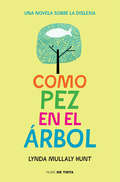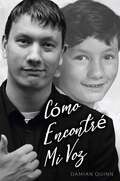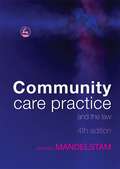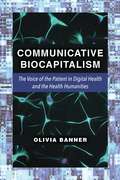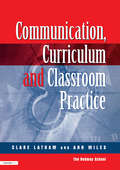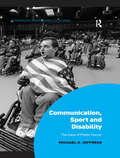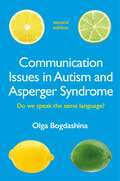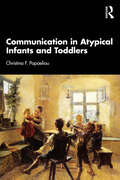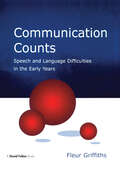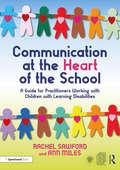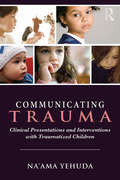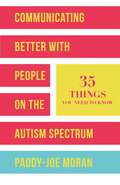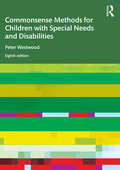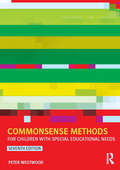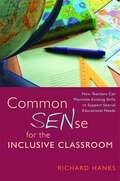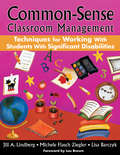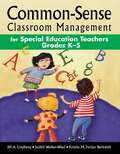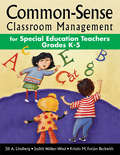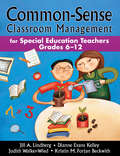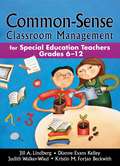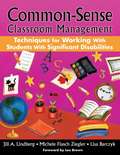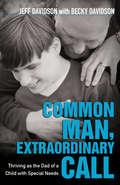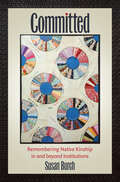- Table View
- List View
Como pez en el árbol: Una novela sobre la dislexia
by Lynda Mullaly HuntUna historia emotiva e inspiradora que llegará a todos aquellos que alguna vez han sentido que no encajaban. «Todos somos genios. Pero si juzgas a un pez por su habilidad paratrepar a los árboles, pasará toda su vida sintiéndose un estúpido.»Albert Einstein, disléxico Ally es una maestra en el arte del engaño. Cada vez que llega a un nuevo colegio, esconde su incapacidad de leer creando inteligentes pero extrañas distracciones a su alrededor. Tiene miedo de pedir ayuda. Y, además, ¿es que alguien puede curar la estupidez? Pero su nuevo profesor ha visto el brillo y la creatividad oculta tras su aire problemático. Con su ayuda, Ally aprenderá que la dislexia no es algo de lo que avergonzarse, mientras se abre ante ella un mundo lleno de posibilidades. Porque cada uno de nosotros llevamos un océano dentro, y las grandes mentes no suelen pensar como lo hacen los demás. La crítica ha dicho...«Conmovedora... Con el énfasis en "pensar de forma diferente". Los fans de R.J. Palacio apreciarán esta historia que ensalza el valor de la amistad y de la inteligencia no convencionales.»Kirkus Reviews «Una historia llena de personajes únicos dibujados con el corazón. Una novela sobre la dislexia, algo tan único como su heroína.»Booklist «Los lectores... adorarán a esta maravillosa protagonista.»The Horn Book
Cómo Encontré Mi Voz
by Damian Quinn"...las palabras siempre conservarán su poder. Las palabras ofrecen los medios para encontrar el significado y, para aquellos que escuchan, el enunciado de la verdad". - V, 2005 El poder de la comunicación es fundamental; algunos dirían que una necesidad. Todos tenemos ese poder: humanos, insectos, aves, gatos, perros, etc. No importa a cual especie pertenezcamos, todos nos comunicamos. Lamentablemente, a algunas personas se les dificulta, y Damian fue una de ellas. El Trastorno del Desarrollo del Lenguaje, una discapacidad del habla y del lenguaje que padece Damian desde su nacimiento, hace que las frases sean confusas y lentas, incluso si las ideas de Damian son claras. Aquí Damian habla acerca de cómo el TDL ha impactado su vida, y como la organización benéfica Afasic ha estado ahí para ayudarle durante todo el trayecto. Damian tropezó con muchas dificultades a lo largo de su vida para lograr hablar. Cómo encontré mi voz relata el viaje de Damian, desde sus primeros años, sus dificultades para encontrar un diagnóstico y que la enfermedad fuera reconocida, hasta ser escuchado como vicepresidente de Afasic.
The Community of the Blind: Applying the Theory of Community Formation
by Yoon Hough KimDr. Kim has investigated the validity of the widely-held view that while there are a large number of blind persons whose social lives are centered in the mainstream, that is with sighted persons, there are an equally large number of blind persons whose social lives are restricted mainly to other blind persons.
Community Care Practice and the Law: Fourth Edition
by Michael MandelstamThis fourth edition of Community Care Practice and the Law has been fully updated to reflect the rapid and continuing legal, policy and practice changes affecting community care. It provides comprehensive and jargon-free explanations of community care legislation, as well as other areas of law directly relevant to practitioners, including the NHS, disabled facilities grants and housing adaptations, asylum and immigration, mental capacity, human rights, disability discrimination, health and safety at work and negligence - and a range of legal provisions relevant to the protection and safeguarding of adults. Apart from the burgeoning legal case law and ombudsman investigations, changes from the last edition include coverage of the Mental Capacity Act 2005, legal implications of 'self directed care' and 'individual budgets', changes to direct payments and 'ordinary residence' determinations. In particular, new guidance applies to the high profile issue of NHS continuing health care. The book is an essential guide for practitioners and managers in both the statutory and voluntary sectors, policy makers in local authorities and the NHS, advocates, lawyers and social work students.
Communicative Biocapitalism: The Voice of the Patient in Digital Health and the Health Humanities
by Olivia BannerThe Precision Medicine Initiative, Apple’s HealthKit, the FitBit—the booming digital health industry asserts that digital networks, tools, and the scientific endeavors they support will usher in a new era of medicine centered around “the voice of the patient.” But whose “voices” do such tools actually solicit? And through what perspective will those voices be heard? Digital health tools are marketed as neutral devices made to help users take responsibility for their health. Yet digital technologies are not neutral; they are developed from an existing set of assumptions about their potential users and contexts for use, and they reflect dominant ideologies of health, dis/ability, gender, and race. Using patient-networking websites, the Quantified Self, and online breast cancer narratives, Communicative Biocapitalism examines the cultural, technological, economic, and rhetorical logics that shape the “voice of the patient” in digital health to identify how cultural understandings and social locations of race, gender, and disability intertwine with whose voices are elicited and how they are interpreted.
Communications,Curriculum and Classroom Practice
by Ann Miles Clare LathanThis book discusses the development of English (Communication and Literacy) for children below level one of the National Curriculum. The authors take account of the latest QCA guidelines for pupils with significantly below age-related expectations.
Communication, Sport and Disability: The Case of Power Soccer (Interdisciplinary Disability Studies)
by Michael S. JeffressSports are ubiquitous in American society, and given their prominence in the culture, it is easy to understand how most youth in the United States face pressure to participate in organized sports. But what does this mean for the hundreds of thousands of Americans who live with one or more physical disabilities and, in particular, those in powered wheelchairs? Located at the intersection of sports and disability, this book tells the story of power soccer - the first competitive team sport specifically designed for electric wheelchair users. Beginning in France in the 1970s, today, over sixty teams compete within the United States Power Soccer Association (USPSA) and the sport is actively played in over thirty countries. Using ethnographic research conducted while attending practices, games, and social functions of teams from across the nation, Jeffress builds a strong case that electric wheelchair users deserve more opportunity to play sports. They deserve it because they need the same physical and psychosocial benefits from participation as their peers, who have full use of their arms and legs. It challenges the social constructions and barriers that currently stand in the way. Most importantly, this book tells the story of some amazing power soccer athletes. It is a moving, first-hand account of what power soccer means to them and the implications this has for society.
Communication Issues in Autism and Asperger Syndrome, Second Edition: Do we speak the same language?
by Olga BogdashinaIn this updated edition, Olga Bogdashina provides a theoretical foundation for understanding communication and language impairments specific to autism. She explores the effects of different perceptual and cognitive styles on the communication and language development of autistic children. She also stresses the importance of identifying each individual's nonverbal language - which can be visual, tactile, kinaesthetic, auditory, olfactory or gustatory - to establish verbal communication. Reflecting recent research and changes in terminology, the book explains why some approaches may work for some autistic children but not for others, and the 'What They Say' sections allow the reader to see through the eyes of autistic individuals and understand their language differences first-hand. 'What We Can Do to Help' sections throughout the book give practical recommendations for helping autistic individuals use their natural mechanisms to learn and develop social and communicative skills. The final chapters are devoted to assessment and intervention issues with recommendations for selecting appropriate methods and techniques to enhance communication, based on the specific mode of communication a person uses.
Communication in Atypical Infants and Toddlers
by Christina F. PapaeliouThis book presents a comparative review of the latest studies and data on prelinguistic communication and early semantic development in autism spectrum disorder (ASD), Williams syndrome (WMS), attention-deficit/hyperactivity disorder (ADHD), and early language delay. Papaeliou offers a critical analysis of the literature, compares key theoretical approaches, and interprets data on development in atypical populations.A fruitful synthesis of theory and research reveals that, instead of cognitive deficits, the core feature of these neurodevelopmental disorders consists of deficits in the ability for self- and intersubjective coordination, which adversely affects early interactions and, consequently, the emergence of language. The book composes fragmentary proposals on the role of rhythm disruptions in different conditions, setting out the idea that disruption in interactional synchrony is a connecting thread through neurodevelopmental disorders which show high prevalence or high comorbidity rates. Papaeliou identifies distinct communicative patterns characteristic of each disorder and puts forward a unifying theory for interpreting data on early communication and language development in atypical populations.This is ideal reading for psychologists, psycholinguists, psychiatrists, paediatricians, speech therapists, and special educators. Students in developmental psychology and anyone interested in understanding the research behind typical and atypical development will also benefit from this text.
Communication Counts: Speech and Language Difficulties in the Early Years
by Fleur GriffithsProfessionals in early years settings can use this book to focus on ways in which they can work collaboratively with colleagues, in order to help children with communication difficulties to understand and express themselves more fully. It brings together the most useful examples of good practice and draws on the work of reflective practitioners. There are many illustrative case studies provided and it discusses how to observe children's daily interactions, ways in which such observations can be used to improve communication skills; how play can be an important part of improvement; behavior management and support; and literacy development. The practical applications are highlighted throughout the book and the advice given comes directly from those working in early years settings. It should be of great interest to all nursery teachers, teaching assistants, speech and language therapists and parents wishing to play an active part in their children's development of language and communication skills.
Communication at the Heart of the School: A Guide for Practitioners Working with Children with Learning Disabilities
by Rachel Sawford Ann MilesCommunication at the Heart of the School introduces a simple, practical approach for communication development in schools, with a specific focus on children with Severe Learning Difficulties (SLD) or Profound and Multiple Learning Difficulties (PMLD). The tried-and-tested framework offers a shared approach to communication development between teachers and speech and language therapists, moving through three crucial stages: the communication assessment, the communication pathway and the classroom environment. It provides a clear structure for the role of each professional and explains how they contribute to every aspect of the child’s communication development. Key features include: A communication pathway that follows a yearly cycle of assessment, plan and intervention, identifying specific communication needs and offering advice on creating communication-friendly environments A focus on the shared vision of teachers and speech and language therapists, creating a united and team-led approach to communication development, ensuring that both therapists and teachers feel supported in tackling complex communication challenges effectively Photocopiable and downloadable assessment forms for accurately measuring outcomes in a time-friendly and accessible way Underpinned by the Communication and Cognitive Framework currently used by teachers, speech and language therapists and families, this resource offers a complete package of communication support. It is an essential tool for speech and language therapists and teachers supporting children communicating at early developmental levels.
Communicating Trauma: Clinical Presentations and Interventions with Traumatized Children
by Na'Ama YehudaCommunicating Trauma explores the various aspects of language and communication and how their development can be affected by childhood trauma and overwhelm. Multiple case-study vignettes describe how different kinds of childhood trauma can manifest in children's ability to relate, attend, learn, and communicate. <P><P> These examples offer ways to understand, respond, and support children who are communicating overwhelm. In this book, psychotherapists, speech-language pathologists, social workers, educators, occupational and physical therapists, medical personnel, foster parents, adoption agencies, and other child professionals and caregivers will find information and practical direction for improving connection and behavior, reducing miscommunication, and giving a voice to those who are often our most challenging children.
Communicating Effectively with People with a Learning Disability
by Sue ThurmanIf you are working within the learning disability sector and studying for the QCF Diploma in Health and Social Care, you will find this book invaluable in helping you to achieve the unit on Communicating effectively. It explain how communication affects all aspects of your work, including relationships, and provides guidance on how to overcome barriers to good communication. The book is easy to navigate, with each chapter covering one of the learning outcomes within the unit. Each chapter begins with an example taken from real people's stories and lots of activities, photographs and other illustrations are included throughout.
Communicating Better with People on the Autism Spectrum: 35 Things You Need to Know
by Paddy-Joe MoranCovering verbal and non-verbal communication, Paddy-Joe Moran presents 35 simple tips and strategies to help professionals improve their communication and relationships with individuals on the autism spectrum. The language that professionals choose to use can have a long-term impact on autistic people. This book provides easy-to-implement suggestions to guarantee effective and sensitive communication. It explains everything from person-first language through to the use of specific, rather than open-ended, questions, and a focus on taking the individual's lead with their preferred language and terminology is central to the book.
Commonsense Methods for Children with Special Needs and Disabilities
by Peter WestwoodThis fully revised and updated eighth edition of Peter Westwood’s book offers practical advice and strategies for meeting the challenge of inclusive teaching. Based on the latest international research from the field, it offers practical advice on both new and well-tried evidence-based approaches and strategies for teaching students with a wide range of difficulties. As well as covering special educational needs, learning difficulties, and disabilities in detail, chapters also explore topics such as self-management and autonomy, managing behaviour, and social skills. The book offers sound pedagogical practices and strategies for adapting curriculum content, designing teaching materials, differentiating instruction for mixed-ability classes, and implementing inclusive assessment of learning. Key features of this new edition include: Additional information on linking all aspects of teaching to a Response-to-Intervention Model A focus on the increasing importance of digital technology in supporting the learning of students with special educational needs and disabilities Up-to-date resource lists for each chapter, for those who wish to pursue a particular topic in greater depth Reflecting cutting-edge international research and teaching practices, this is an invaluable resource for practising and trainee teachers, teaching assistants, and other educational professionals looking to support students with special educational needs and disabilities.
Commonsense Methods for Children with Special Educational Needs
by Peter WestwoodThis fully revised and updated seventh edition of Commonsense Methods for Children with Special Educational Needs continues to offer practical advice on evidence-based teaching methods and intervention strategies for helping children with a wide range of disabilities or difficulties. The advice the author provides is embedded within a clear theoretical context and draws on the latest international research and literature from the field. Coverage includes: learning difficulties and disabilities students with autism spectrum disorders, intellectual disability, physical or health issues, and sensory impairments gifted and talented students developing social skills and self-management behaviour management teaching methods literacy and numeracy curriculum differentiation and adaptive teaching computer-based instruction and e-learning. Peter Westwood also provides additional information and advice on transition from school to employment for students with disabilities, lesson study, e-learning, and computer-aided instruction, and reflects on the important changes made within the latest Diagnostic and Statistical Manual of Mental Disorders (DSM-5).
Common SENse for the Inclusive Classroom
by Richard HanksThis book condenses everything the mainstream teacher needs to know about Special Educational Needs into one short volume, allowing them to pick and choose teaching methods that suit them and each individual student. Following a revolutionary 'a la carte' concept, the book acts first and foremost as a teaching menu, offering a variety of options that teachers can use as they see fit. Written in a jargon-free, accessible style, the author gets to the heart of issues associated with teaching mixed ability classes, offering more flexible alternatives to traditional teaching strategies and suggesting helpful approaches that really work. Maintaining that teachers are usually far more capable of handling situations than they believe themselves to be, the book allows them to choose methods that suit their own personal style and the specific needs of their students. Essential background information on special educational needs including dyslexia, dyspraxia, Asperger's Syndrome and Attention Deficit Hyperactivity Disorder is included throughout. Combining practical methodology with factual information about learning difficulties, this guide will be an invaluable resource for non-specialist teachers supporting children with special educational needs in inclusive classrooms.
Common-Sense Classroom Management Techniques for Working With Students With Significant Disabilities
by Jill A. Lindberg Michele F. Ziegler Lisa BarczykThis invaluable handbook provides teachers with common-sense strategies, tools, and templates to ensure the best possible educational outcomes for learners with significant disabilities.
Common-Sense Classroom Management for Special Education Teachers Grades K5: For Special Education Teachers, Grades 6-12 (Common-sense Classroom Management Ser.)
by Jill A. Lindberg Kristin M. Forjan Beckwith Judith Walker-WiedSpecial help for special education teachers means special success for students!Do you have too many IEPs on your desk? Is it five o'clock and do you still need to contact parents, social workers, and general education co-teachers? Teachers new to special education often feel overwhelmed at the amount of additional planning and information management required.This practical guide shows you how to shape the structure of the teaching day to ensure that learners with special needs experience success. It includes simple teacher-tested, easy-to-implement strategies needing 5 steps or fewer to: Organize students to make the most of the time you have with them Use incentive programs and meaningful consequences to achieve desired behaviors Coordinate with co-teachers, general education teachers, and staff to maximize your effortsSpecial Education teachers face different challenges, paperwork shouldn't be one of them. When the key paperwork is at your fingertips, the lesson plan is prepared, and the to-do list is written, you will find more time in your day for what's most important-your students!
Common-Sense Classroom Management for Special Education Teachers, Grades K-5
by Jill A. Lindberg Judith K. Walker-Wied Kristin M. BeckwithThis practical guide gives teachers simple strategies for organizing their classrooms and pacing their day to ensure that learners with special needs experience success.
Common-Sense Classroom Management for Special Education Teachers, Grades 6-12
by Jill A. Lindberg Dianne Evans Kelley Judith K. Walker-Wied Kristin M. BeckwithThese 80 easy to adapt strategies work in five steps or fewer to help special educators feel confident about working with co-teachers, teacher aides, support staff, administrators, and families.
Common-Sense Classroom Management: For Special Education Teachers, Grades 6-12 (1-off Ser.)
by Jill A. Lindberg Dianne Evans Kelley Judith Walker-Wied Kristin M. Forjan BeckwithIf you're a teacher new to special education, this book is for you! This newest Common-Sense Classroom Management guide addresses the most critical challenges that arise when teaching adolescent learners with special needs. In this flexible and easy-to-implement resource, educators will find 80 concise and teacher-tested strategies. Each strategy works in five steps or fewer, helping special educators feel competent and confident about working with co-teachers, teacher aides, support staff, administrators, and families. The authors, all special education experts, provide practical assistance with: * Specially designed instruction and student organization to make teaching more effective * Legal responsibilities aligned with IDEIA and NCLB requirements * Positive behavioral supports, including incentive programs and meaningful consequences Ideal for teachers new to special education, teacher trainers, and teacher mentors, this resource provides a clear-sighted focus to help you shape the structure of each teaching day and ensure success for all your learners with special needs!
Common-Sense Classroom Management: Techniques for Working with Students with Significant Disabilities
by Jill A. Lindberg Michele Flasch Ziegler Lisa BarczykToday's diverse classrooms challenge even the most experienced teachers. Using an easy-to-read format, this resource offers tools and techniques that teachers can use to reach all learners, particularly those with more significant disabilities, and give them the support they need to succeed.
Common Man, Extraordinary Call: Thriving as the Dad of a Child with Special Needs
by Jeff Davidson Becky DavidsonChallenges, equips, and inspires fathers of children with special needsBecoming the father of a child with special needs can feel like being drafted into the military--and starting duty as a general. Dad is expected to know how to set rules and run drills without any training in leadership. And there are very few resources for men who want to be involved but need guidance and specific ideas. Overwhelmed, many fathers end up going AWOL on their families.As a twenty-year veteran of special-needs parenting, Jeff Davidson wrote a field manual to give fathers the skills required for the day-to-day demands of parenting. Jeff helps men discover God's new mission for their lives in each of five specific roles: warrior, protector, provider, encourager, and equipper. He offers rich, real-life examples from dads in the field and a no-nonsense approach from initial diagnosis onward. This book is filled with practical how-tos for parenting in the special needs world, bullet points for easy reading and quick reference, and a Mission Critical synopsis at the end of each chapter.Informal and task-oriented, Common Man, Extraordinary Call offers growth and hope for men with little free time. And as they process their instructions, they'll be able to mentor other fathers, creating a strong army of men who not only survive but thrive as capable dads to their children with special needs.
Committed: Remembering Native Kinship in and beyond Institutions (Critical Indigeneities)
by Susan BurchBetween 1902 and 1934, the United States confined hundreds of adults and children from dozens of Native nations at the Canton Asylum for Insane Indians, a federal psychiatric hospital in South Dakota. But detention at the Indian Asylum, as families experienced it, was not the beginning or end of the story. For them, Canton Asylum was one of many places of imposed removal and confinement, including reservations, boarding schools, orphanages, and prison-hospitals. Despite the long reach of institutionalization for those forcibly held at the Asylum, the tenacity of relationships extended within and beyond institutional walls. In this accessible and innovative work, Susan Burch tells the story of the Indigenous people—families, communities, and nations, across generations to the present day—who have experienced the impact of this history. Drawing on oral history interviews, correspondence, material objects, and archival sources, Burch reframes the histories of institutionalized people and the places that held them. Committed expands the boundaries of Native American history, disability studies, and U.S. social and cultural history generally.
